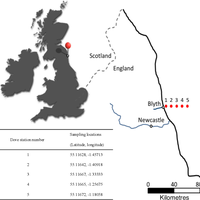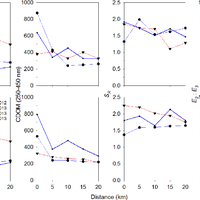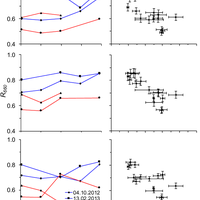Abstract
Understanding the physical and biogeochemical controls of air-sea gas exchange is necessary for establishing biogeochemical models for predicting regional- and global-scale trace gas fluxes and feedbacks. To this end we report the results of experiments designed to constrain the effect of surfactants in the sea surface microlayer (SML) on the gas transfer velocity (kw;cmh-1), seasonally (2012-2013) along a 20km coastal transect (North East UK). We measured total surfactant activity (SA), chromophoric dissolved organic matter (CDOM) and chlorophyll a (Chl a) in the SML and in sub-surface water (SSW) and we evaluated corresponding kw values using a custom-designed air-sea gas exchange tank. Temporal SA variability exceeded its spatial variability. Overall, SA varied 5-fold between all samples (0.08 to 0.38mgL-1 T-X-100), being highest in the SML during summer. SML SA enrichment factors (EFs) relative to SSW were ∼ 1.0 to 1.9, except for two values (0.75; 0.89: February 2013). The range in corresponding k660 (kw for CO2 in seawater at 20°C) was 6.8 to 22.0cmh-1. The film factor R660 (the ratio of k660 for seawater to k660 for "clean", i.e. surfactant-free, laboratory water) was strongly correlated with SML SA (r ≥ 0.70, p ≤ 0.002, each n Combining double low line 16). High SML SA typically corresponded to k660 suppressions ∼ 14 to 51% relative to clean laboratory water, highlighting strong spatiotemporal gradients in gas exchange due to varying surfactant in these coastal waters. Such variability should be taken account of when evaluating marine trace gas sources and sinks. Total CDOM absorbance (250 to 450nm), the CDOM spectral slope ratio (SR Combining double low line S275 - 295ĝ•S350 - 400), the 250 : 365nm CDOM absorption ratio (E2:E3), and Chl a all indicated spatial and temporal signals in the quantity and composition of organic matter in the SML and SSW. This prompts us to hypothesise that spatiotemporal variation in R660 and its relationship with SA is a consequence of compositional differences in the surfactant fraction of the SML DOM pool that warrants further investigation.
Figures
Register to see more suggestions
Mendeley helps you to discover research relevant for your work.
Cite
CITATION STYLE
Pereira, R., Schneider-Zapp, K., & Upstill-Goddard, R. C. (2016). Surfactant control of gas transfer velocity along an offshore coastal transect: Results from a laboratory gas exchange tank. Biogeosciences, 13(13), 3981–3989. https://doi.org/10.5194/bg-13-3981-2016




